Strategic Management of Human Resources Report: Concepts and Relations
VerifiedAdded on 2023/01/06
|17
|4139
|24
Report
AI Summary
This report delves into the realm of Strategic Human Resource Management (SHRM), examining the crucial link between business strategy and human resource strategy. It explores the concepts of vertical alignment and horizontal integration within HRM, highlighting their importance for organizational success. The report discusses various SHRM models and theories, including best fit/contingency, best practice/universalist, and resource-based view, providing insights into their applications. Furthermore, it analyzes specific HR practices like performance management and reward systems, offering recommendations for their effective implementation. The report also investigates the nature of employment relations, the roles of actors within it, and the changing dynamics of these relationships, providing recommendations for improvement. Overall, the report provides a comprehensive overview of SHRM and its practical implications.
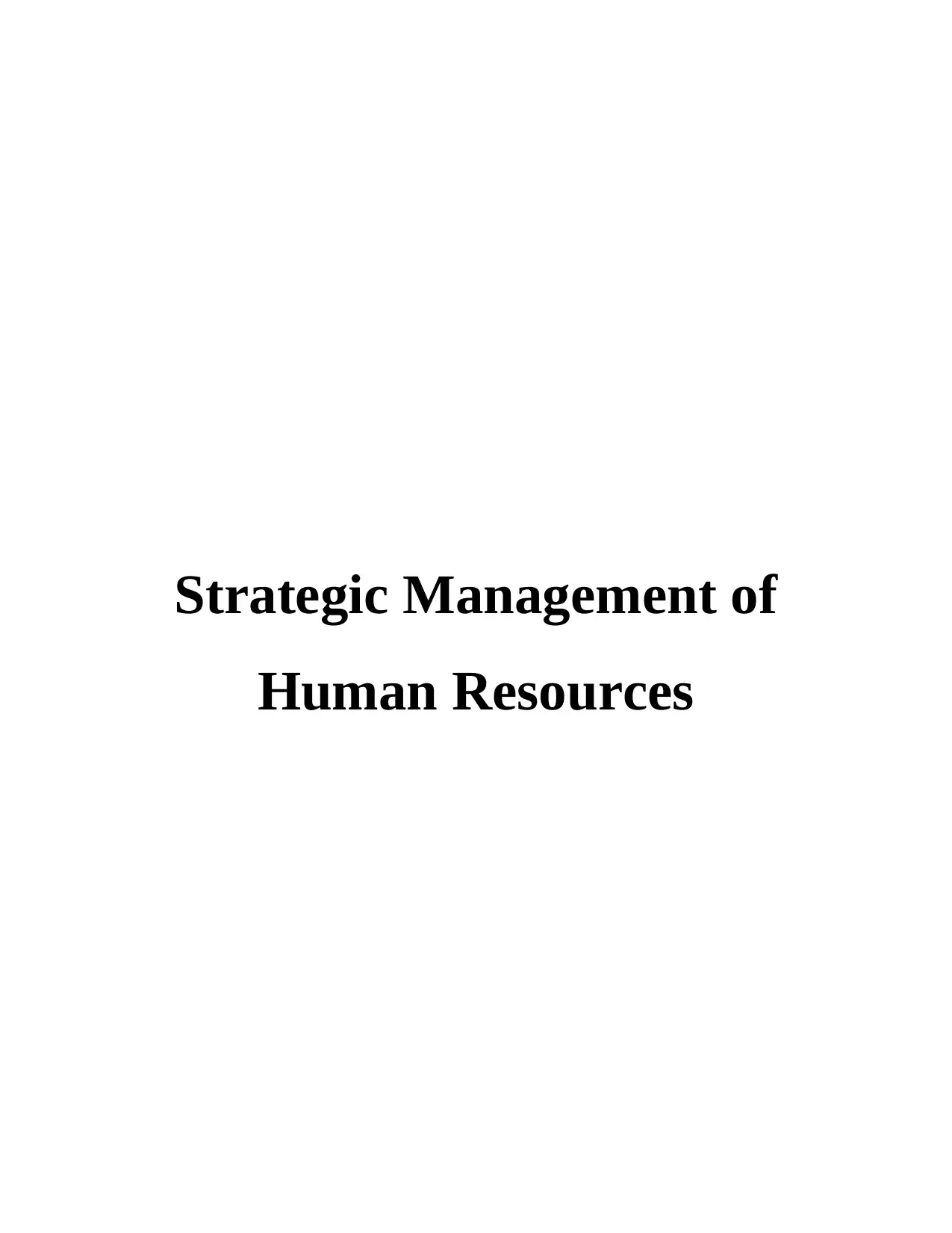
Strategic Management of
Human Resources
Human Resources
Paraphrase This Document
Need a fresh take? Get an instant paraphrase of this document with our AI Paraphraser
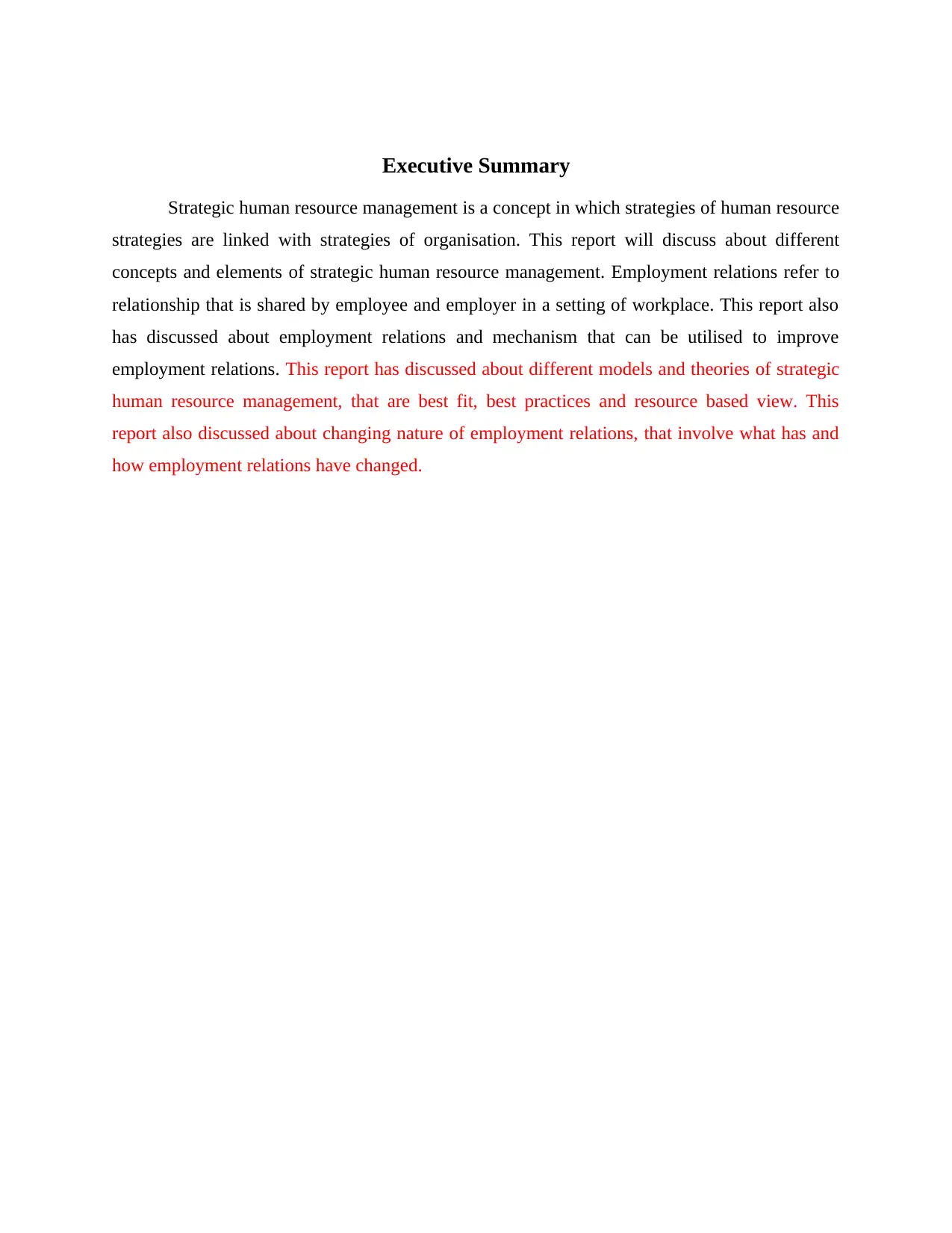
Executive Summary
Strategic human resource management is a concept in which strategies of human resource
strategies are linked with strategies of organisation. This report will discuss about different
concepts and elements of strategic human resource management. Employment relations refer to
relationship that is shared by employee and employer in a setting of workplace. This report also
has discussed about employment relations and mechanism that can be utilised to improve
employment relations. This report has discussed about different models and theories of strategic
human resource management, that are best fit, best practices and resource based view. This
report also discussed about changing nature of employment relations, that involve what has and
how employment relations have changed.
Strategic human resource management is a concept in which strategies of human resource
strategies are linked with strategies of organisation. This report will discuss about different
concepts and elements of strategic human resource management. Employment relations refer to
relationship that is shared by employee and employer in a setting of workplace. This report also
has discussed about employment relations and mechanism that can be utilised to improve
employment relations. This report has discussed about different models and theories of strategic
human resource management, that are best fit, best practices and resource based view. This
report also discussed about changing nature of employment relations, that involve what has and
how employment relations have changed.
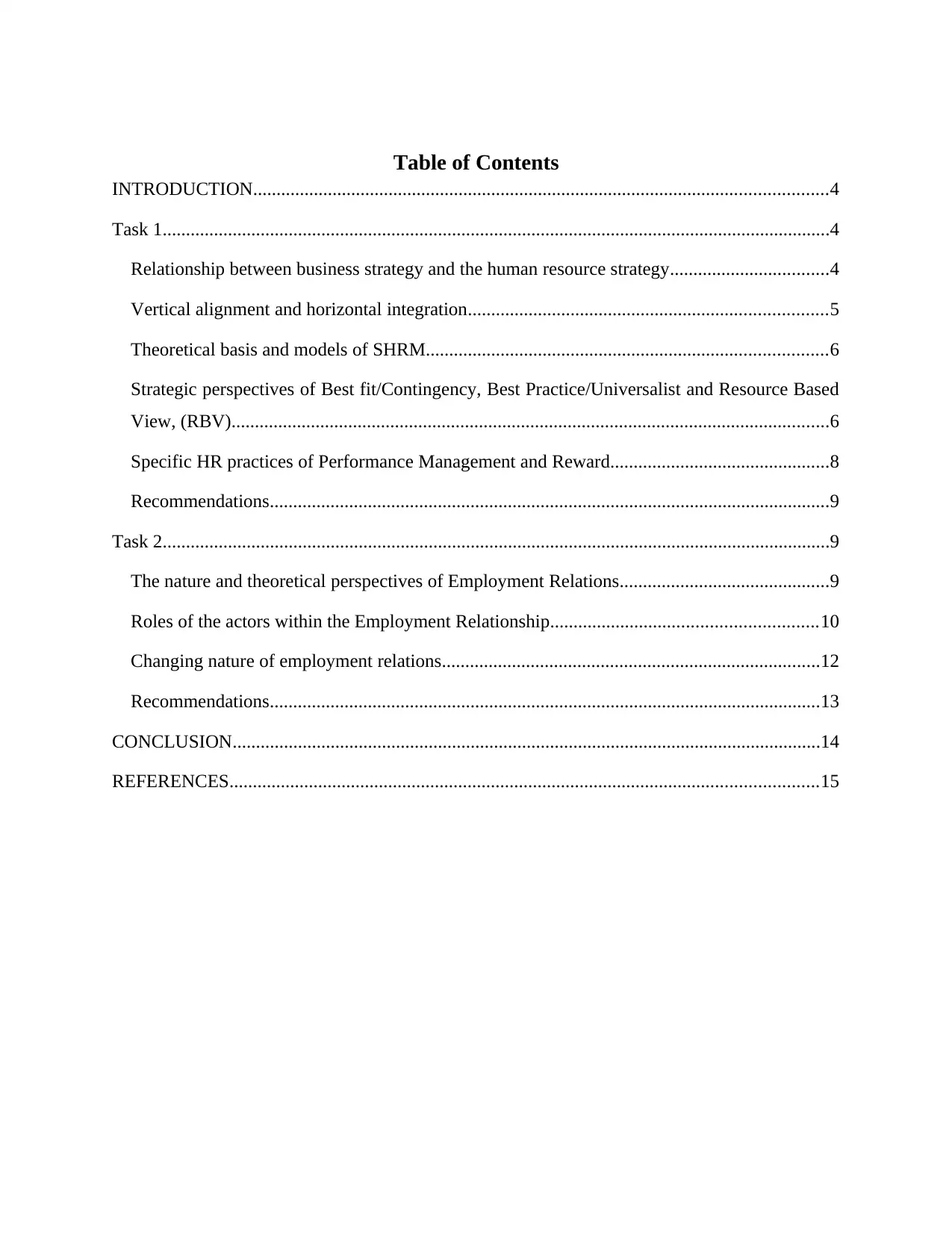
Table of Contents
INTRODUCTION...........................................................................................................................4
Task 1...............................................................................................................................................4
Relationship between business strategy and the human resource strategy..................................4
Vertical alignment and horizontal integration.............................................................................5
Theoretical basis and models of SHRM......................................................................................6
Strategic perspectives of Best fit/Contingency, Best Practice/Universalist and Resource Based
View, (RBV)................................................................................................................................6
Specific HR practices of Performance Management and Reward...............................................8
Recommendations........................................................................................................................9
Task 2...............................................................................................................................................9
The nature and theoretical perspectives of Employment Relations.............................................9
Roles of the actors within the Employment Relationship.........................................................10
Changing nature of employment relations.................................................................................12
Recommendations......................................................................................................................13
CONCLUSION..............................................................................................................................14
REFERENCES..............................................................................................................................15
INTRODUCTION...........................................................................................................................4
Task 1...............................................................................................................................................4
Relationship between business strategy and the human resource strategy..................................4
Vertical alignment and horizontal integration.............................................................................5
Theoretical basis and models of SHRM......................................................................................6
Strategic perspectives of Best fit/Contingency, Best Practice/Universalist and Resource Based
View, (RBV)................................................................................................................................6
Specific HR practices of Performance Management and Reward...............................................8
Recommendations........................................................................................................................9
Task 2...............................................................................................................................................9
The nature and theoretical perspectives of Employment Relations.............................................9
Roles of the actors within the Employment Relationship.........................................................10
Changing nature of employment relations.................................................................................12
Recommendations......................................................................................................................13
CONCLUSION..............................................................................................................................14
REFERENCES..............................................................................................................................15
⊘ This is a preview!⊘
Do you want full access?
Subscribe today to unlock all pages.

Trusted by 1+ million students worldwide
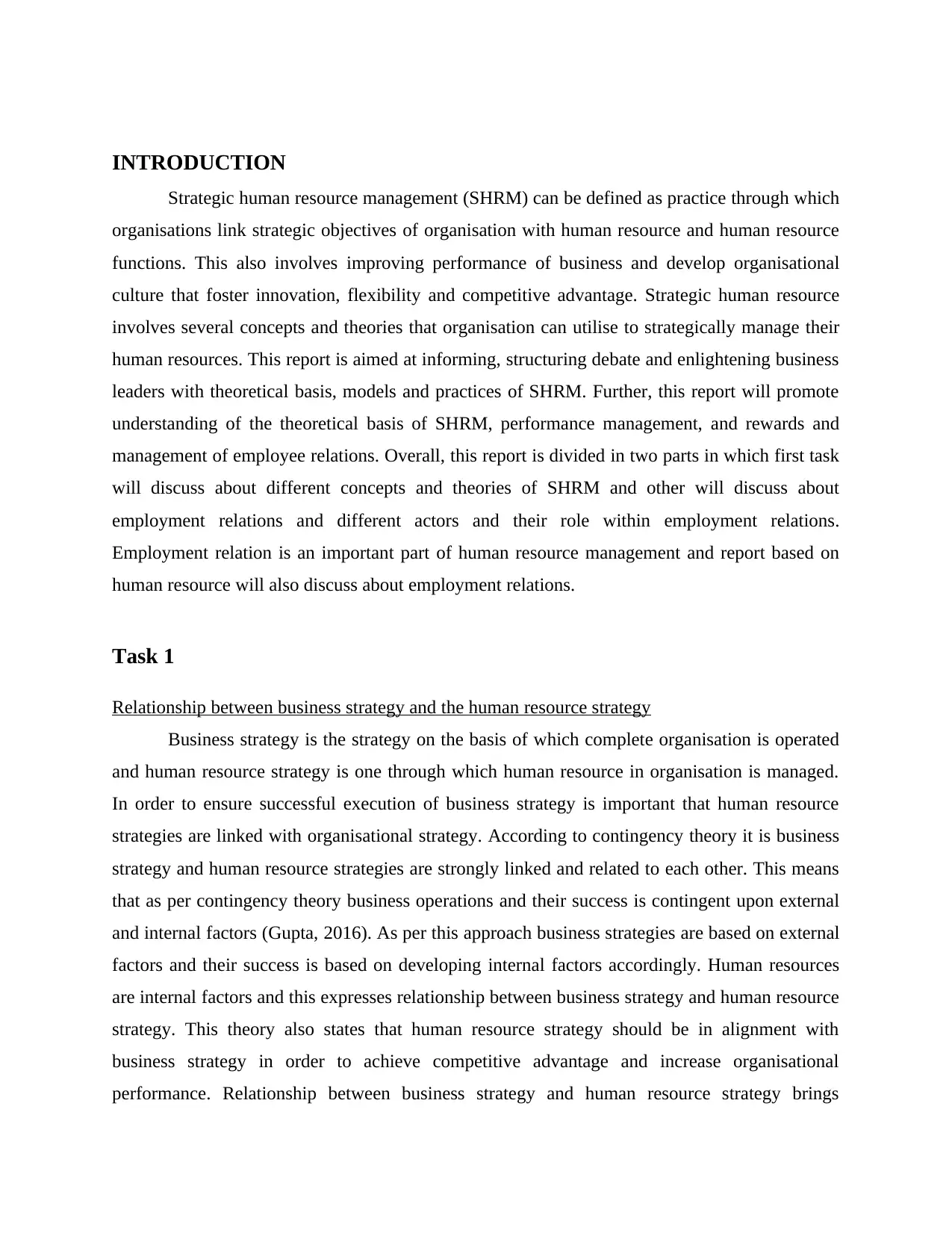
INTRODUCTION
Strategic human resource management (SHRM) can be defined as practice through which
organisations link strategic objectives of organisation with human resource and human resource
functions. This also involves improving performance of business and develop organisational
culture that foster innovation, flexibility and competitive advantage. Strategic human resource
involves several concepts and theories that organisation can utilise to strategically manage their
human resources. This report is aimed at informing, structuring debate and enlightening business
leaders with theoretical basis, models and practices of SHRM. Further, this report will promote
understanding of the theoretical basis of SHRM, performance management, and rewards and
management of employee relations. Overall, this report is divided in two parts in which first task
will discuss about different concepts and theories of SHRM and other will discuss about
employment relations and different actors and their role within employment relations.
Employment relation is an important part of human resource management and report based on
human resource will also discuss about employment relations.
Task 1
Relationship between business strategy and the human resource strategy
Business strategy is the strategy on the basis of which complete organisation is operated
and human resource strategy is one through which human resource in organisation is managed.
In order to ensure successful execution of business strategy is important that human resource
strategies are linked with organisational strategy. According to contingency theory it is business
strategy and human resource strategies are strongly linked and related to each other. This means
that as per contingency theory business operations and their success is contingent upon external
and internal factors (Gupta, 2016). As per this approach business strategies are based on external
factors and their success is based on developing internal factors accordingly. Human resources
are internal factors and this expresses relationship between business strategy and human resource
strategy. This theory also states that human resource strategy should be in alignment with
business strategy in order to achieve competitive advantage and increase organisational
performance. Relationship between business strategy and human resource strategy brings
Strategic human resource management (SHRM) can be defined as practice through which
organisations link strategic objectives of organisation with human resource and human resource
functions. This also involves improving performance of business and develop organisational
culture that foster innovation, flexibility and competitive advantage. Strategic human resource
involves several concepts and theories that organisation can utilise to strategically manage their
human resources. This report is aimed at informing, structuring debate and enlightening business
leaders with theoretical basis, models and practices of SHRM. Further, this report will promote
understanding of the theoretical basis of SHRM, performance management, and rewards and
management of employee relations. Overall, this report is divided in two parts in which first task
will discuss about different concepts and theories of SHRM and other will discuss about
employment relations and different actors and their role within employment relations.
Employment relation is an important part of human resource management and report based on
human resource will also discuss about employment relations.
Task 1
Relationship between business strategy and the human resource strategy
Business strategy is the strategy on the basis of which complete organisation is operated
and human resource strategy is one through which human resource in organisation is managed.
In order to ensure successful execution of business strategy is important that human resource
strategies are linked with organisational strategy. According to contingency theory it is business
strategy and human resource strategies are strongly linked and related to each other. This means
that as per contingency theory business operations and their success is contingent upon external
and internal factors (Gupta, 2016). As per this approach business strategies are based on external
factors and their success is based on developing internal factors accordingly. Human resources
are internal factors and this expresses relationship between business strategy and human resource
strategy. This theory also states that human resource strategy should be in alignment with
business strategy in order to achieve competitive advantage and increase organisational
performance. Relationship between business strategy and human resource strategy brings
Paraphrase This Document
Need a fresh take? Get an instant paraphrase of this document with our AI Paraphraser
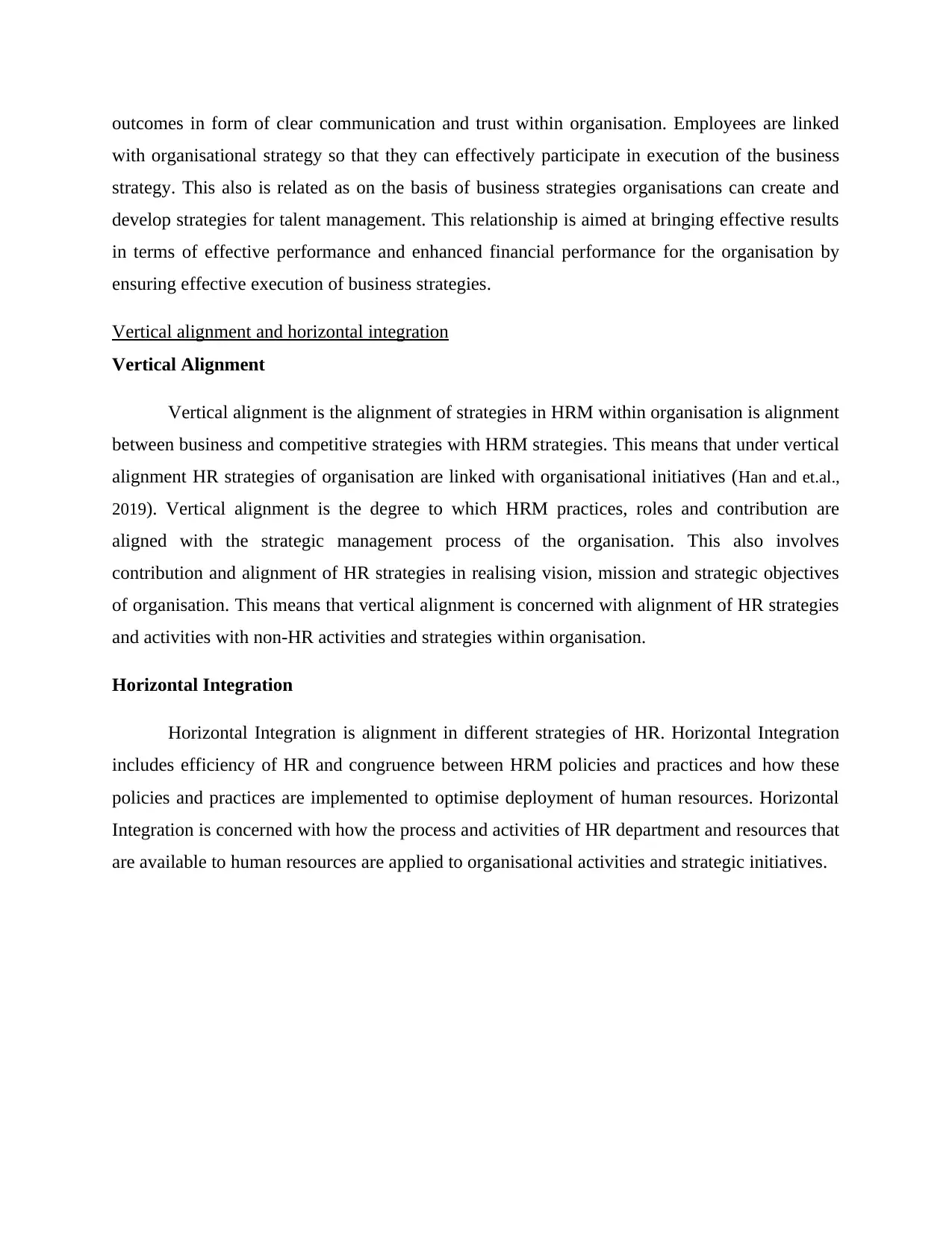
outcomes in form of clear communication and trust within organisation. Employees are linked
with organisational strategy so that they can effectively participate in execution of the business
strategy. This also is related as on the basis of business strategies organisations can create and
develop strategies for talent management. This relationship is aimed at bringing effective results
in terms of effective performance and enhanced financial performance for the organisation by
ensuring effective execution of business strategies.
Vertical alignment and horizontal integration
Vertical Alignment
Vertical alignment is the alignment of strategies in HRM within organisation is alignment
between business and competitive strategies with HRM strategies. This means that under vertical
alignment HR strategies of organisation are linked with organisational initiatives (Han and et.al.,
2019). Vertical alignment is the degree to which HRM practices, roles and contribution are
aligned with the strategic management process of the organisation. This also involves
contribution and alignment of HR strategies in realising vision, mission and strategic objectives
of organisation. This means that vertical alignment is concerned with alignment of HR strategies
and activities with non-HR activities and strategies within organisation.
Horizontal Integration
Horizontal Integration is alignment in different strategies of HR. Horizontal Integration
includes efficiency of HR and congruence between HRM policies and practices and how these
policies and practices are implemented to optimise deployment of human resources. Horizontal
Integration is concerned with how the process and activities of HR department and resources that
are available to human resources are applied to organisational activities and strategic initiatives.
with organisational strategy so that they can effectively participate in execution of the business
strategy. This also is related as on the basis of business strategies organisations can create and
develop strategies for talent management. This relationship is aimed at bringing effective results
in terms of effective performance and enhanced financial performance for the organisation by
ensuring effective execution of business strategies.
Vertical alignment and horizontal integration
Vertical Alignment
Vertical alignment is the alignment of strategies in HRM within organisation is alignment
between business and competitive strategies with HRM strategies. This means that under vertical
alignment HR strategies of organisation are linked with organisational initiatives (Han and et.al.,
2019). Vertical alignment is the degree to which HRM practices, roles and contribution are
aligned with the strategic management process of the organisation. This also involves
contribution and alignment of HR strategies in realising vision, mission and strategic objectives
of organisation. This means that vertical alignment is concerned with alignment of HR strategies
and activities with non-HR activities and strategies within organisation.
Horizontal Integration
Horizontal Integration is alignment in different strategies of HR. Horizontal Integration
includes efficiency of HR and congruence between HRM policies and practices and how these
policies and practices are implemented to optimise deployment of human resources. Horizontal
Integration is concerned with how the process and activities of HR department and resources that
are available to human resources are applied to organisational activities and strategic initiatives.
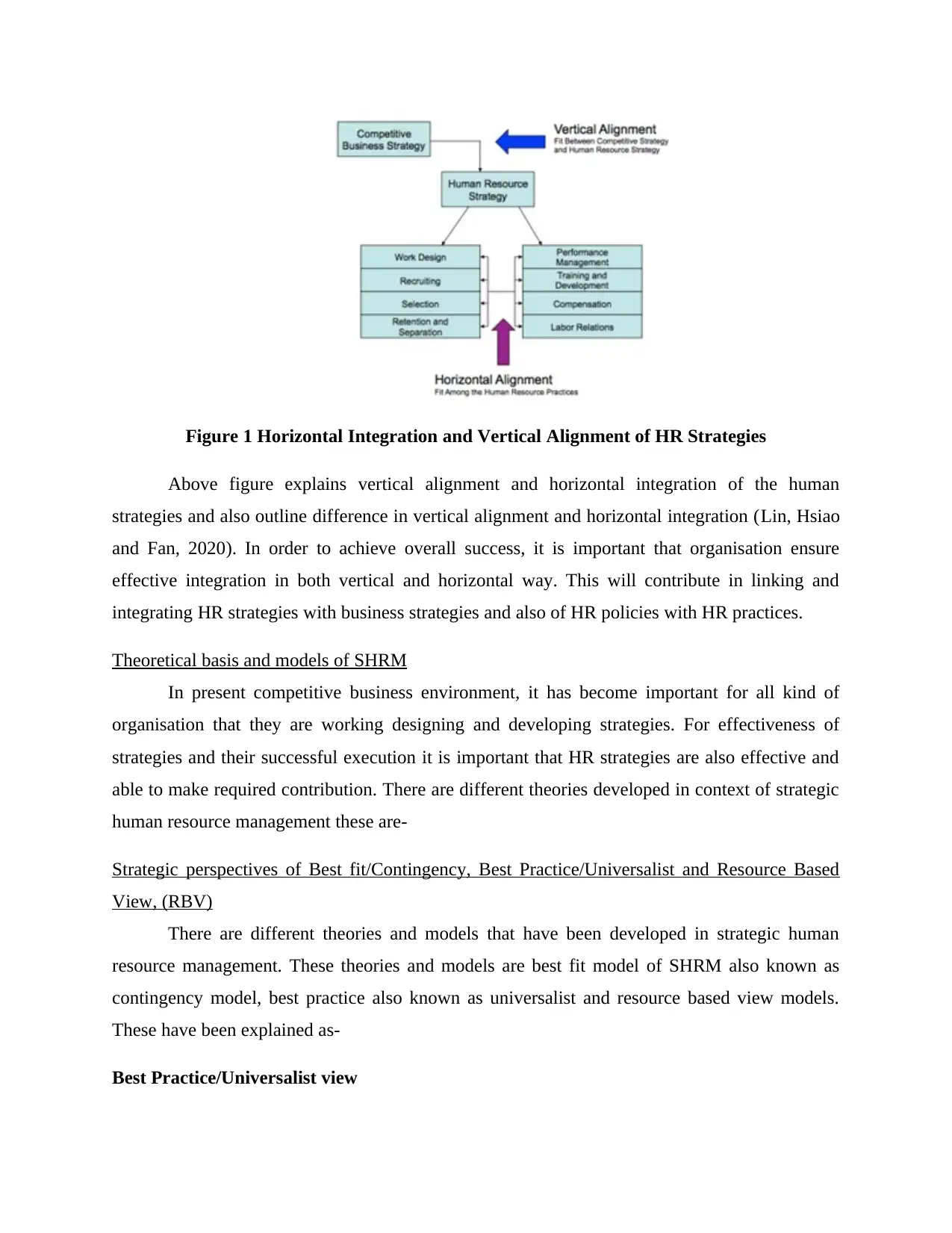
Figure 1 Horizontal Integration and Vertical Alignment of HR Strategies
Above figure explains vertical alignment and horizontal integration of the human
strategies and also outline difference in vertical alignment and horizontal integration (Lin, Hsiao
and Fan, 2020). In order to achieve overall success, it is important that organisation ensure
effective integration in both vertical and horizontal way. This will contribute in linking and
integrating HR strategies with business strategies and also of HR policies with HR practices.
Theoretical basis and models of SHRM
In present competitive business environment, it has become important for all kind of
organisation that they are working designing and developing strategies. For effectiveness of
strategies and their successful execution it is important that HR strategies are also effective and
able to make required contribution. There are different theories developed in context of strategic
human resource management these are-
Strategic perspectives of Best fit/Contingency, Best Practice/Universalist and Resource Based
View, (RBV)
There are different theories and models that have been developed in strategic human
resource management. These theories and models are best fit model of SHRM also known as
contingency model, best practice also known as universalist and resource based view models.
These have been explained as-
Best Practice/Universalist view
Above figure explains vertical alignment and horizontal integration of the human
strategies and also outline difference in vertical alignment and horizontal integration (Lin, Hsiao
and Fan, 2020). In order to achieve overall success, it is important that organisation ensure
effective integration in both vertical and horizontal way. This will contribute in linking and
integrating HR strategies with business strategies and also of HR policies with HR practices.
Theoretical basis and models of SHRM
In present competitive business environment, it has become important for all kind of
organisation that they are working designing and developing strategies. For effectiveness of
strategies and their successful execution it is important that HR strategies are also effective and
able to make required contribution. There are different theories developed in context of strategic
human resource management these are-
Strategic perspectives of Best fit/Contingency, Best Practice/Universalist and Resource Based
View, (RBV)
There are different theories and models that have been developed in strategic human
resource management. These theories and models are best fit model of SHRM also known as
contingency model, best practice also known as universalist and resource based view models.
These have been explained as-
Best Practice/Universalist view
⊘ This is a preview!⊘
Do you want full access?
Subscribe today to unlock all pages.

Trusted by 1+ million students worldwide
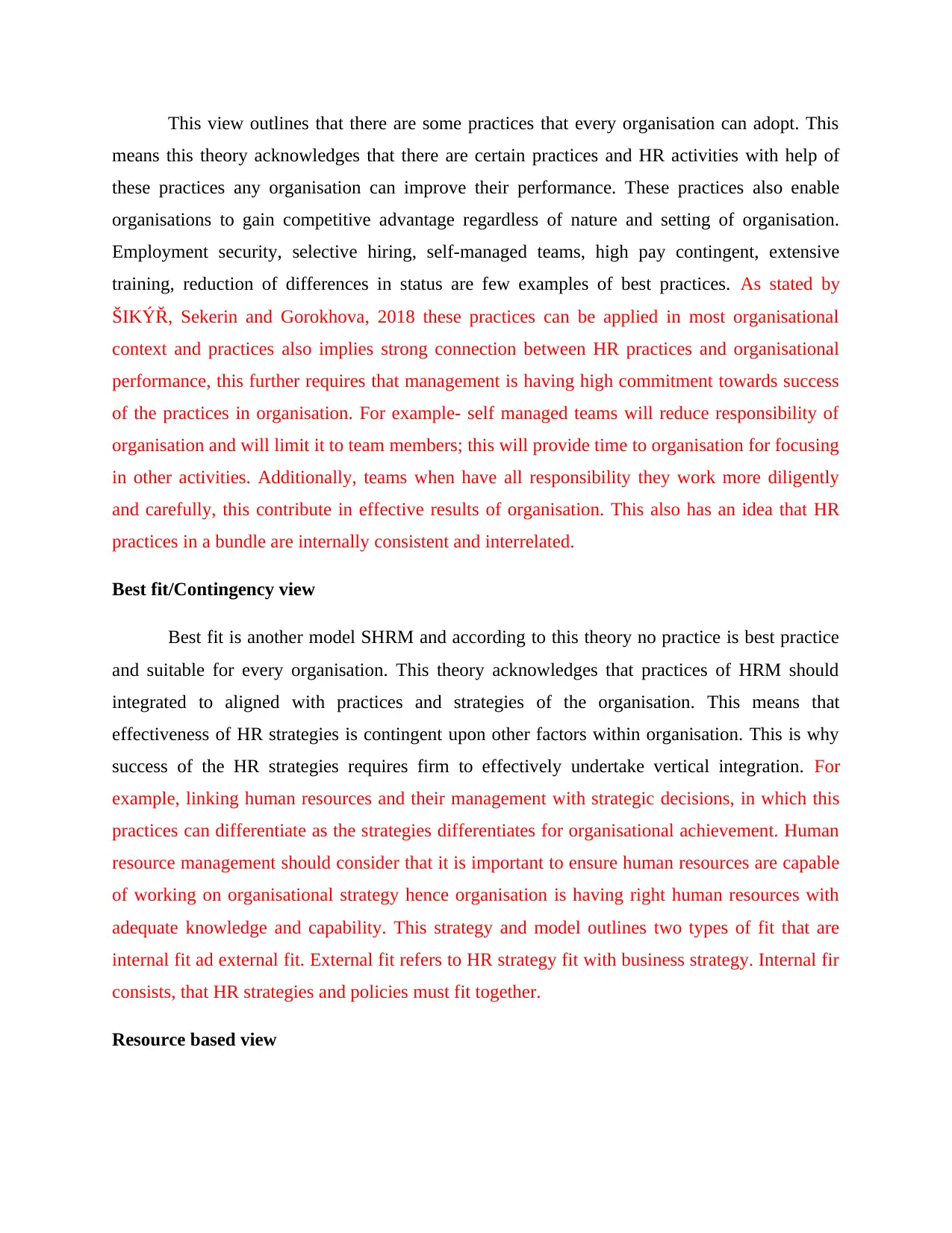
This view outlines that there are some practices that every organisation can adopt. This
means this theory acknowledges that there are certain practices and HR activities with help of
these practices any organisation can improve their performance. These practices also enable
organisations to gain competitive advantage regardless of nature and setting of organisation.
Employment security, selective hiring, self-managed teams, high pay contingent, extensive
training, reduction of differences in status are few examples of best practices. As stated by
ŠIKÝŘ, Sekerin and Gorokhova, 2018 these practices can be applied in most organisational
context and practices also implies strong connection between HR practices and organisational
performance, this further requires that management is having high commitment towards success
of the practices in organisation. For example- self managed teams will reduce responsibility of
organisation and will limit it to team members; this will provide time to organisation for focusing
in other activities. Additionally, teams when have all responsibility they work more diligently
and carefully, this contribute in effective results of organisation. This also has an idea that HR
practices in a bundle are internally consistent and interrelated.
Best fit/Contingency view
Best fit is another model SHRM and according to this theory no practice is best practice
and suitable for every organisation. This theory acknowledges that practices of HRM should
integrated to aligned with practices and strategies of the organisation. This means that
effectiveness of HR strategies is contingent upon other factors within organisation. This is why
success of the HR strategies requires firm to effectively undertake vertical integration. For
example, linking human resources and their management with strategic decisions, in which this
practices can differentiate as the strategies differentiates for organisational achievement. Human
resource management should consider that it is important to ensure human resources are capable
of working on organisational strategy hence organisation is having right human resources with
adequate knowledge and capability. This strategy and model outlines two types of fit that are
internal fit ad external fit. External fit refers to HR strategy fit with business strategy. Internal fir
consists, that HR strategies and policies must fit together.
Resource based view
means this theory acknowledges that there are certain practices and HR activities with help of
these practices any organisation can improve their performance. These practices also enable
organisations to gain competitive advantage regardless of nature and setting of organisation.
Employment security, selective hiring, self-managed teams, high pay contingent, extensive
training, reduction of differences in status are few examples of best practices. As stated by
ŠIKÝŘ, Sekerin and Gorokhova, 2018 these practices can be applied in most organisational
context and practices also implies strong connection between HR practices and organisational
performance, this further requires that management is having high commitment towards success
of the practices in organisation. For example- self managed teams will reduce responsibility of
organisation and will limit it to team members; this will provide time to organisation for focusing
in other activities. Additionally, teams when have all responsibility they work more diligently
and carefully, this contribute in effective results of organisation. This also has an idea that HR
practices in a bundle are internally consistent and interrelated.
Best fit/Contingency view
Best fit is another model SHRM and according to this theory no practice is best practice
and suitable for every organisation. This theory acknowledges that practices of HRM should
integrated to aligned with practices and strategies of the organisation. This means that
effectiveness of HR strategies is contingent upon other factors within organisation. This is why
success of the HR strategies requires firm to effectively undertake vertical integration. For
example, linking human resources and their management with strategic decisions, in which this
practices can differentiate as the strategies differentiates for organisational achievement. Human
resource management should consider that it is important to ensure human resources are capable
of working on organisational strategy hence organisation is having right human resources with
adequate knowledge and capability. This strategy and model outlines two types of fit that are
internal fit ad external fit. External fit refers to HR strategy fit with business strategy. Internal fir
consists, that HR strategies and policies must fit together.
Resource based view
Paraphrase This Document
Need a fresh take? Get an instant paraphrase of this document with our AI Paraphraser
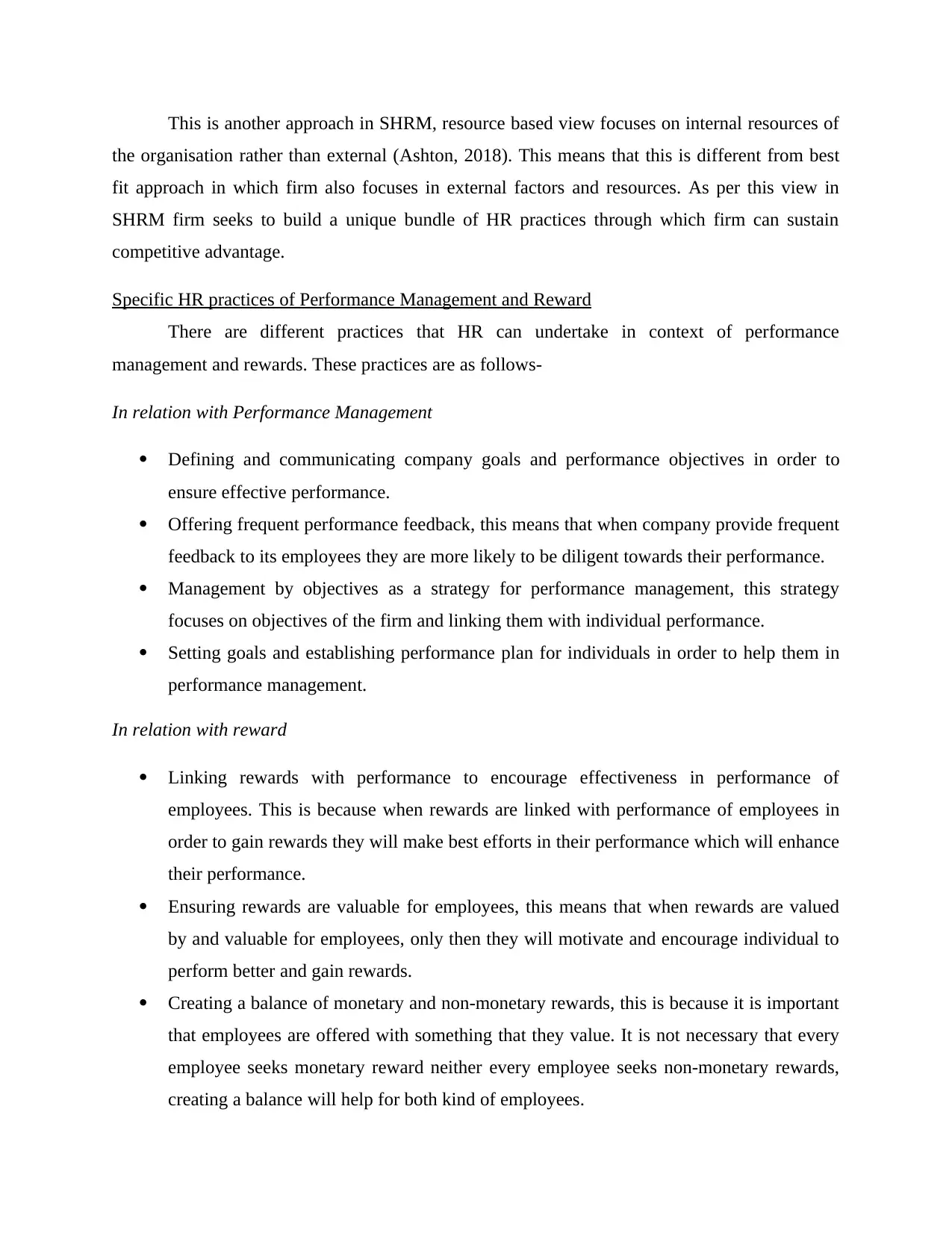
This is another approach in SHRM, resource based view focuses on internal resources of
the organisation rather than external (Ashton, 2018). This means that this is different from best
fit approach in which firm also focuses in external factors and resources. As per this view in
SHRM firm seeks to build a unique bundle of HR practices through which firm can sustain
competitive advantage.
Specific HR practices of Performance Management and Reward
There are different practices that HR can undertake in context of performance
management and rewards. These practices are as follows-
In relation with Performance Management
Defining and communicating company goals and performance objectives in order to
ensure effective performance.
Offering frequent performance feedback, this means that when company provide frequent
feedback to its employees they are more likely to be diligent towards their performance.
Management by objectives as a strategy for performance management, this strategy
focuses on objectives of the firm and linking them with individual performance.
Setting goals and establishing performance plan for individuals in order to help them in
performance management.
In relation with reward
Linking rewards with performance to encourage effectiveness in performance of
employees. This is because when rewards are linked with performance of employees in
order to gain rewards they will make best efforts in their performance which will enhance
their performance.
Ensuring rewards are valuable for employees, this means that when rewards are valued
by and valuable for employees, only then they will motivate and encourage individual to
perform better and gain rewards.
Creating a balance of monetary and non-monetary rewards, this is because it is important
that employees are offered with something that they value. It is not necessary that every
employee seeks monetary reward neither every employee seeks non-monetary rewards,
creating a balance will help for both kind of employees.
the organisation rather than external (Ashton, 2018). This means that this is different from best
fit approach in which firm also focuses in external factors and resources. As per this view in
SHRM firm seeks to build a unique bundle of HR practices through which firm can sustain
competitive advantage.
Specific HR practices of Performance Management and Reward
There are different practices that HR can undertake in context of performance
management and rewards. These practices are as follows-
In relation with Performance Management
Defining and communicating company goals and performance objectives in order to
ensure effective performance.
Offering frequent performance feedback, this means that when company provide frequent
feedback to its employees they are more likely to be diligent towards their performance.
Management by objectives as a strategy for performance management, this strategy
focuses on objectives of the firm and linking them with individual performance.
Setting goals and establishing performance plan for individuals in order to help them in
performance management.
In relation with reward
Linking rewards with performance to encourage effectiveness in performance of
employees. This is because when rewards are linked with performance of employees in
order to gain rewards they will make best efforts in their performance which will enhance
their performance.
Ensuring rewards are valuable for employees, this means that when rewards are valued
by and valuable for employees, only then they will motivate and encourage individual to
perform better and gain rewards.
Creating a balance of monetary and non-monetary rewards, this is because it is important
that employees are offered with something that they value. It is not necessary that every
employee seeks monetary reward neither every employee seeks non-monetary rewards,
creating a balance will help for both kind of employees.
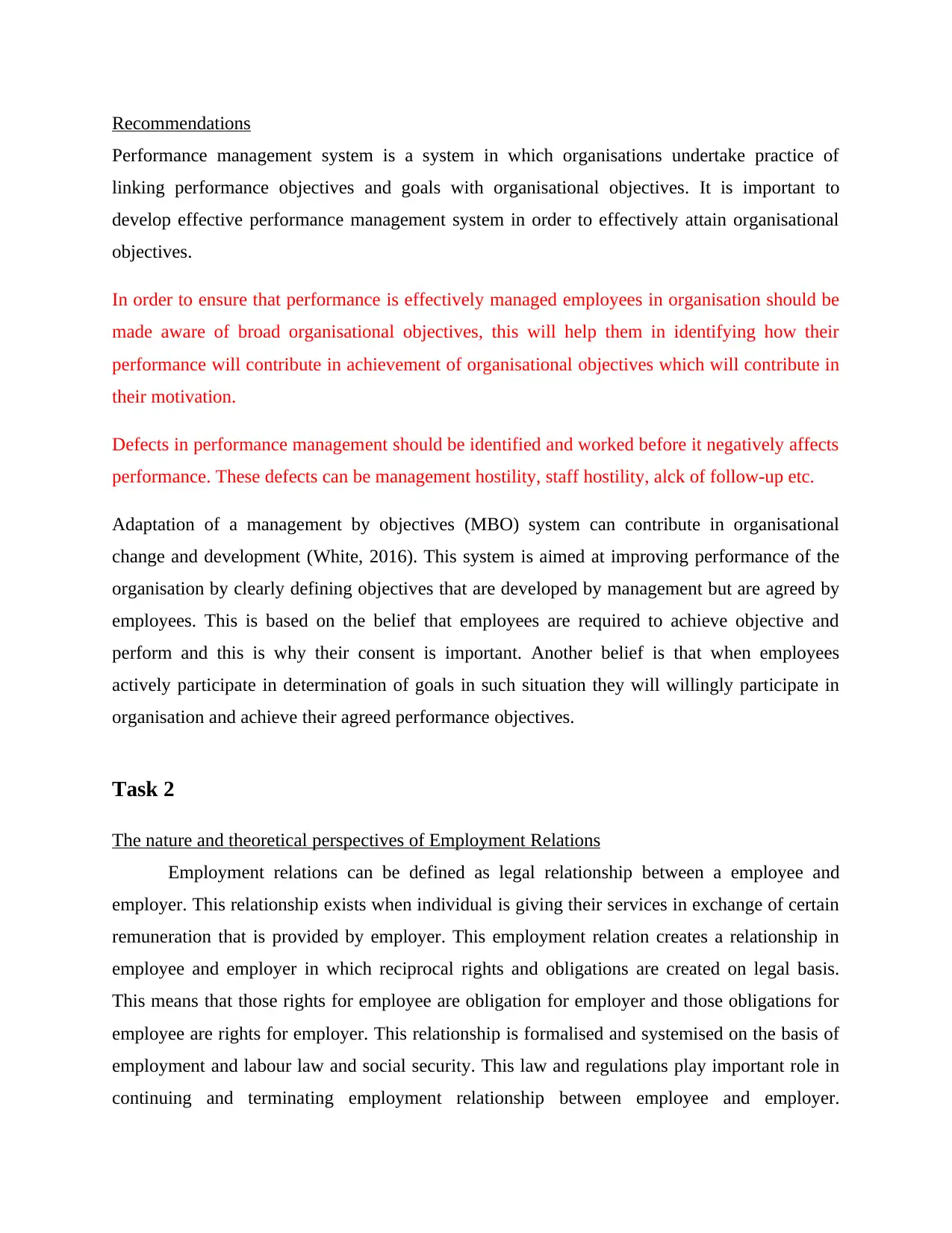
Recommendations
Performance management system is a system in which organisations undertake practice of
linking performance objectives and goals with organisational objectives. It is important to
develop effective performance management system in order to effectively attain organisational
objectives.
In order to ensure that performance is effectively managed employees in organisation should be
made aware of broad organisational objectives, this will help them in identifying how their
performance will contribute in achievement of organisational objectives which will contribute in
their motivation.
Defects in performance management should be identified and worked before it negatively affects
performance. These defects can be management hostility, staff hostility, alck of follow-up etc.
Adaptation of a management by objectives (MBO) system can contribute in organisational
change and development (White, 2016). This system is aimed at improving performance of the
organisation by clearly defining objectives that are developed by management but are agreed by
employees. This is based on the belief that employees are required to achieve objective and
perform and this is why their consent is important. Another belief is that when employees
actively participate in determination of goals in such situation they will willingly participate in
organisation and achieve their agreed performance objectives.
Task 2
The nature and theoretical perspectives of Employment Relations
Employment relations can be defined as legal relationship between a employee and
employer. This relationship exists when individual is giving their services in exchange of certain
remuneration that is provided by employer. This employment relation creates a relationship in
employee and employer in which reciprocal rights and obligations are created on legal basis.
This means that those rights for employee are obligation for employer and those obligations for
employee are rights for employer. This relationship is formalised and systemised on the basis of
employment and labour law and social security. This law and regulations play important role in
continuing and terminating employment relationship between employee and employer.
Performance management system is a system in which organisations undertake practice of
linking performance objectives and goals with organisational objectives. It is important to
develop effective performance management system in order to effectively attain organisational
objectives.
In order to ensure that performance is effectively managed employees in organisation should be
made aware of broad organisational objectives, this will help them in identifying how their
performance will contribute in achievement of organisational objectives which will contribute in
their motivation.
Defects in performance management should be identified and worked before it negatively affects
performance. These defects can be management hostility, staff hostility, alck of follow-up etc.
Adaptation of a management by objectives (MBO) system can contribute in organisational
change and development (White, 2016). This system is aimed at improving performance of the
organisation by clearly defining objectives that are developed by management but are agreed by
employees. This is based on the belief that employees are required to achieve objective and
perform and this is why their consent is important. Another belief is that when employees
actively participate in determination of goals in such situation they will willingly participate in
organisation and achieve their agreed performance objectives.
Task 2
The nature and theoretical perspectives of Employment Relations
Employment relations can be defined as legal relationship between a employee and
employer. This relationship exists when individual is giving their services in exchange of certain
remuneration that is provided by employer. This employment relation creates a relationship in
employee and employer in which reciprocal rights and obligations are created on legal basis.
This means that those rights for employee are obligation for employer and those obligations for
employee are rights for employer. This relationship is formalised and systemised on the basis of
employment and labour law and social security. This law and regulations play important role in
continuing and terminating employment relationship between employee and employer.
⊘ This is a preview!⊘
Do you want full access?
Subscribe today to unlock all pages.

Trusted by 1+ million students worldwide
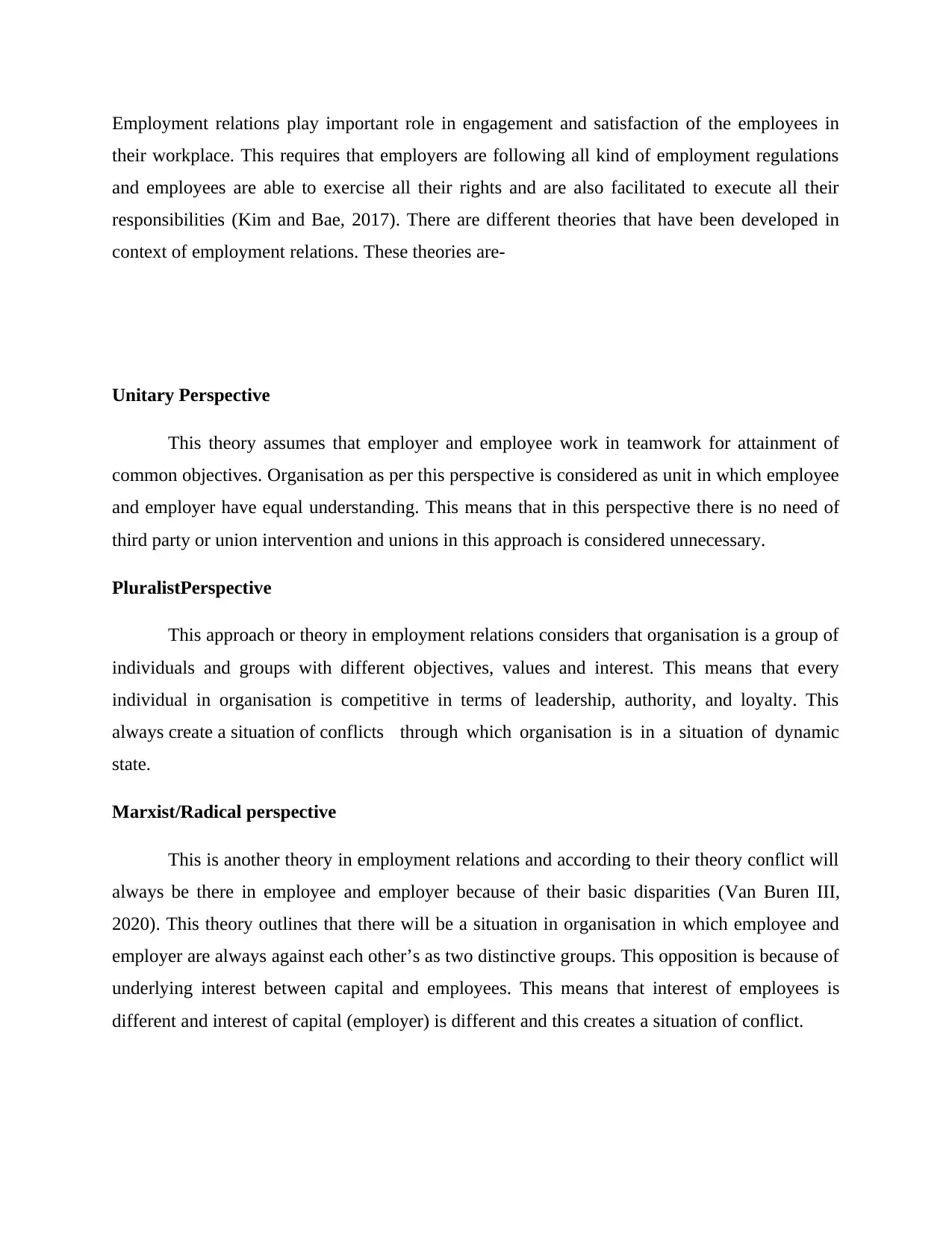
Employment relations play important role in engagement and satisfaction of the employees in
their workplace. This requires that employers are following all kind of employment regulations
and employees are able to exercise all their rights and are also facilitated to execute all their
responsibilities (Kim and Bae, 2017). There are different theories that have been developed in
context of employment relations. These theories are-
Unitary Perspective
This theory assumes that employer and employee work in teamwork for attainment of
common objectives. Organisation as per this perspective is considered as unit in which employee
and employer have equal understanding. This means that in this perspective there is no need of
third party or union intervention and unions in this approach is considered unnecessary.
PluralistPerspective
This approach or theory in employment relations considers that organisation is a group of
individuals and groups with different objectives, values and interest. This means that every
individual in organisation is competitive in terms of leadership, authority, and loyalty. This
always create a situation of conflicts through which organisation is in a situation of dynamic
state.
Marxist/Radical perspective
This is another theory in employment relations and according to their theory conflict will
always be there in employee and employer because of their basic disparities (Van Buren III,
2020). This theory outlines that there will be a situation in organisation in which employee and
employer are always against each other’s as two distinctive groups. This opposition is because of
underlying interest between capital and employees. This means that interest of employees is
different and interest of capital (employer) is different and this creates a situation of conflict.
their workplace. This requires that employers are following all kind of employment regulations
and employees are able to exercise all their rights and are also facilitated to execute all their
responsibilities (Kim and Bae, 2017). There are different theories that have been developed in
context of employment relations. These theories are-
Unitary Perspective
This theory assumes that employer and employee work in teamwork for attainment of
common objectives. Organisation as per this perspective is considered as unit in which employee
and employer have equal understanding. This means that in this perspective there is no need of
third party or union intervention and unions in this approach is considered unnecessary.
PluralistPerspective
This approach or theory in employment relations considers that organisation is a group of
individuals and groups with different objectives, values and interest. This means that every
individual in organisation is competitive in terms of leadership, authority, and loyalty. This
always create a situation of conflicts through which organisation is in a situation of dynamic
state.
Marxist/Radical perspective
This is another theory in employment relations and according to their theory conflict will
always be there in employee and employer because of their basic disparities (Van Buren III,
2020). This theory outlines that there will be a situation in organisation in which employee and
employer are always against each other’s as two distinctive groups. This opposition is because of
underlying interest between capital and employees. This means that interest of employees is
different and interest of capital (employer) is different and this creates a situation of conflict.
Paraphrase This Document
Need a fresh take? Get an instant paraphrase of this document with our AI Paraphraser
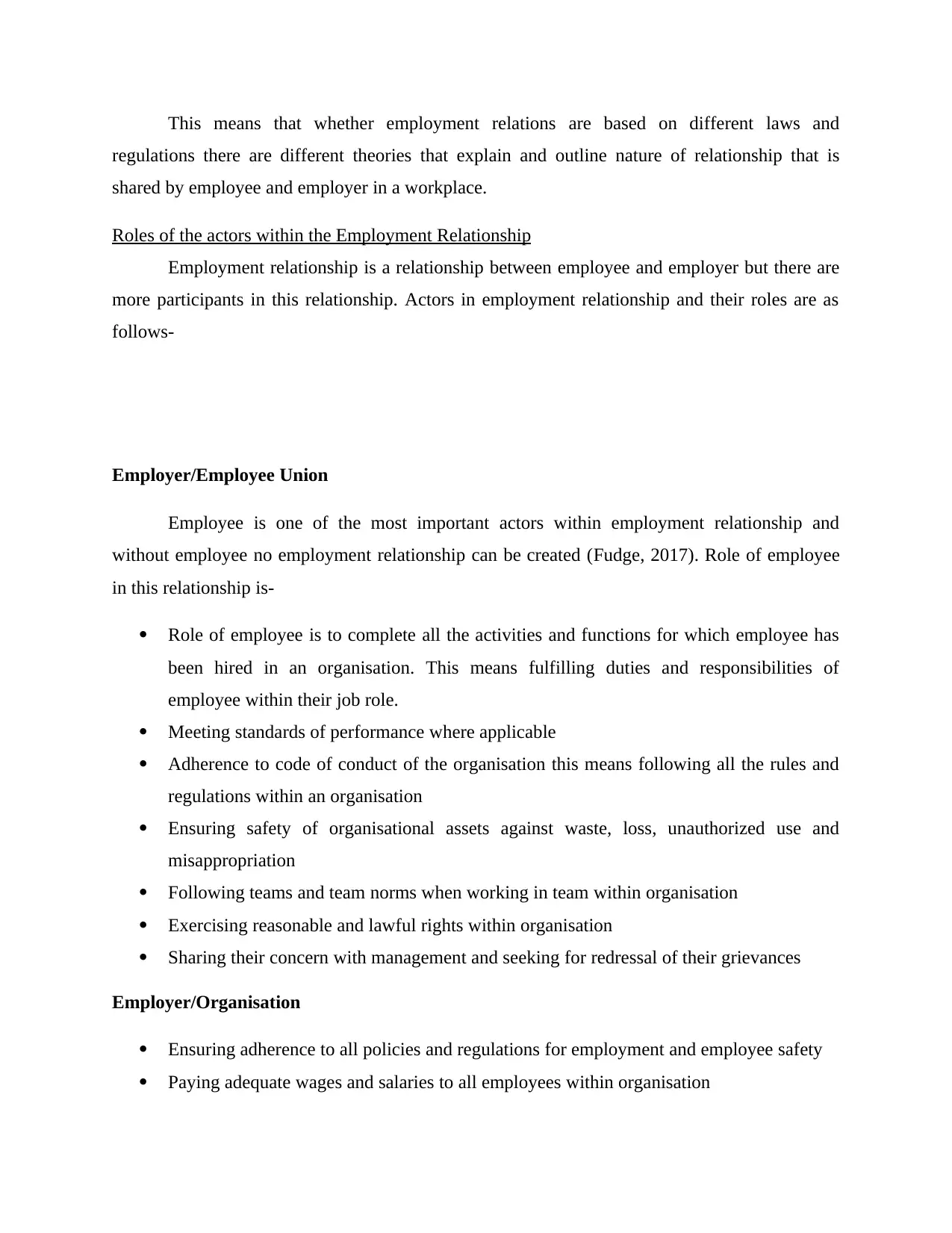
This means that whether employment relations are based on different laws and
regulations there are different theories that explain and outline nature of relationship that is
shared by employee and employer in a workplace.
Roles of the actors within the Employment Relationship
Employment relationship is a relationship between employee and employer but there are
more participants in this relationship. Actors in employment relationship and their roles are as
follows-
Employer/Employee Union
Employee is one of the most important actors within employment relationship and
without employee no employment relationship can be created (Fudge, 2017). Role of employee
in this relationship is-
Role of employee is to complete all the activities and functions for which employee has
been hired in an organisation. This means fulfilling duties and responsibilities of
employee within their job role.
Meeting standards of performance where applicable
Adherence to code of conduct of the organisation this means following all the rules and
regulations within an organisation
Ensuring safety of organisational assets against waste, loss, unauthorized use and
misappropriation
Following teams and team norms when working in team within organisation
Exercising reasonable and lawful rights within organisation
Sharing their concern with management and seeking for redressal of their grievances
Employer/Organisation
Ensuring adherence to all policies and regulations for employment and employee safety
Paying adequate wages and salaries to all employees within organisation
regulations there are different theories that explain and outline nature of relationship that is
shared by employee and employer in a workplace.
Roles of the actors within the Employment Relationship
Employment relationship is a relationship between employee and employer but there are
more participants in this relationship. Actors in employment relationship and their roles are as
follows-
Employer/Employee Union
Employee is one of the most important actors within employment relationship and
without employee no employment relationship can be created (Fudge, 2017). Role of employee
in this relationship is-
Role of employee is to complete all the activities and functions for which employee has
been hired in an organisation. This means fulfilling duties and responsibilities of
employee within their job role.
Meeting standards of performance where applicable
Adherence to code of conduct of the organisation this means following all the rules and
regulations within an organisation
Ensuring safety of organisational assets against waste, loss, unauthorized use and
misappropriation
Following teams and team norms when working in team within organisation
Exercising reasonable and lawful rights within organisation
Sharing their concern with management and seeking for redressal of their grievances
Employer/Organisation
Ensuring adherence to all policies and regulations for employment and employee safety
Paying adequate wages and salaries to all employees within organisation
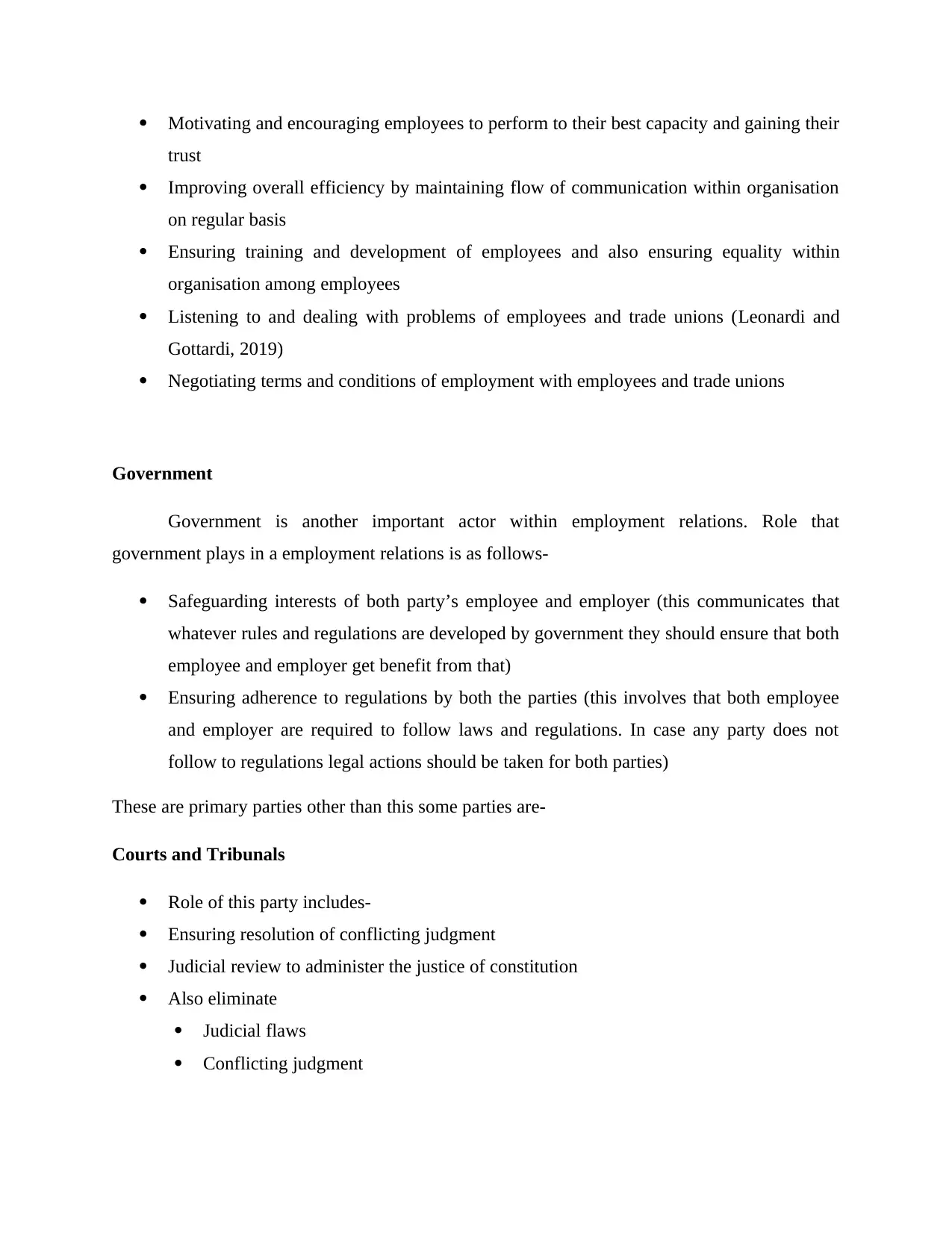
Motivating and encouraging employees to perform to their best capacity and gaining their
trust
Improving overall efficiency by maintaining flow of communication within organisation
on regular basis
Ensuring training and development of employees and also ensuring equality within
organisation among employees
Listening to and dealing with problems of employees and trade unions (Leonardi and
Gottardi, 2019)
Negotiating terms and conditions of employment with employees and trade unions
Government
Government is another important actor within employment relations. Role that
government plays in a employment relations is as follows-
Safeguarding interests of both party’s employee and employer (this communicates that
whatever rules and regulations are developed by government they should ensure that both
employee and employer get benefit from that)
Ensuring adherence to regulations by both the parties (this involves that both employee
and employer are required to follow laws and regulations. In case any party does not
follow to regulations legal actions should be taken for both parties)
These are primary parties other than this some parties are-
Courts and Tribunals
Role of this party includes-
Ensuring resolution of conflicting judgment
Judicial review to administer the justice of constitution
Also eliminate
Judicial flaws
Conflicting judgment
trust
Improving overall efficiency by maintaining flow of communication within organisation
on regular basis
Ensuring training and development of employees and also ensuring equality within
organisation among employees
Listening to and dealing with problems of employees and trade unions (Leonardi and
Gottardi, 2019)
Negotiating terms and conditions of employment with employees and trade unions
Government
Government is another important actor within employment relations. Role that
government plays in a employment relations is as follows-
Safeguarding interests of both party’s employee and employer (this communicates that
whatever rules and regulations are developed by government they should ensure that both
employee and employer get benefit from that)
Ensuring adherence to regulations by both the parties (this involves that both employee
and employer are required to follow laws and regulations. In case any party does not
follow to regulations legal actions should be taken for both parties)
These are primary parties other than this some parties are-
Courts and Tribunals
Role of this party includes-
Ensuring resolution of conflicting judgment
Judicial review to administer the justice of constitution
Also eliminate
Judicial flaws
Conflicting judgment
⊘ This is a preview!⊘
Do you want full access?
Subscribe today to unlock all pages.

Trusted by 1+ million students worldwide
1 out of 17
Related Documents
Your All-in-One AI-Powered Toolkit for Academic Success.
+13062052269
info@desklib.com
Available 24*7 on WhatsApp / Email
![[object Object]](/_next/static/media/star-bottom.7253800d.svg)
Unlock your academic potential
Copyright © 2020–2025 A2Z Services. All Rights Reserved. Developed and managed by ZUCOL.





